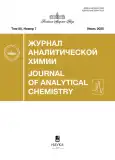Gas chromatographic analysis of the content of the organochlorine pesticide lindane in some samples of agricultural products under primary and secondary cultivation in the same soil
- Authors: Musabirov D.E.1,2, Daukaev R.A.1, Karimov D.O.1, Usmanova E.N.1, Zelenkovskaya E.E.1, Guskov V.Y.2
-
Affiliations:
- Ufa Research Institute of Labor Medicine and Human Ecology
- Ufa University of Science and Technology
- Issue: Vol 80, No 7 (2025)
- Pages: 688-698
- Section: ORIGINAL ARTICLES
- Submitted: 18.08.2025
- URL: https://ogarev-online.ru/0044-4502/article/view/304869
- DOI: https://doi.org/10.31857/S0044450225070048
- EDN: https://elibrary.ru/bhozls
- ID: 304869
Cite item
Abstract
About the authors
D. E. Musabirov
Ufa Research Institute of Labor Medicine and Human Ecology; Ufa University of Science and Technology
Email: 30102000@rambler.ru
Ufa, Republic of Bashkortostan, Russia; Ufa, Republic of Bashkortostan, Russia
R. A. Daukaev
Ufa Research Institute of Labor Medicine and Human EcologyUfa, Republic of Bashkortostan, Russia
D. O. Karimov
Ufa Research Institute of Labor Medicine and Human EcologyUfa, Republic of Bashkortostan, Russia
E. N. Usmanova
Ufa Research Institute of Labor Medicine and Human EcologyUfa, Republic of Bashkortostan, Russia
E. E. Zelenkovskaya
Ufa Research Institute of Labor Medicine and Human EcologyUfa, Republic of Bashkortostan, Russia
V. Y. Guskov
Ufa University of Science and TechnologyUfa, Republic of Bashkortostan, Russia
References
- Медведь Л.И. Справочник по пестицидам (гигиена применения и токсикология). Киев: Урожай, 1974. С. 448.
- Van Dyk J.C., Bouwman H., Barnhoorn I.E. J., Bornman M.S. DDT contamination from indoor residual spraying for malaria control // Sci. Total Environ. 2010. V. 408. № 13. P. 2745. https://doi.org/10.1016/j.scitotenv.2010.03.002
- Mrema E.J., Rubino F.M., Brambilla G., Moretto A., Tsatsakis A.M., Colosio C. Persistent organochlorinated pesticides and mechanisms of their toxicity // Toxicology. 2013. V. 307. P. 74. https://doi.org/10.1016/j.tox.2012.11.015
- Singh Z., Kaur J., Kaur R., Hundal S.S. Toxic effects of organochlorine pesticides: A review // Am. J. BioSci. 2016. V. 12. № 3. P. 11. https://doi.org/10.11648/j.ajbio.s.2016040301.13
- Chopra A.K., Sharma M.K., Chamoli S. Bioaccumulation of organochlorine pesticides in aquatic system – An overview // Environ. Monit. Assess. 2011. V. 173. P. 905. https://doi.org/10.1007/s10661-010-1433-4
- Shen L., Wania F. Compilation, evaluation, and selection of physical – Chemical property data for organochlorine pesticides // J. Chem. Eng. Data. 2005. V. 50. № 3. P. 742. https://doi.org/10.1021/je049693f
- Jayaraj R., Megha P., Sreedev P. Organochlorine pesticides, their toxic effects on living organisms and their fate in the environment // Interdiscip. Toxicol. 2016. V. 9. № 3-4. P. 90. https://doi.org/10.1515/intox-2016-0012
- Mendez M.A., Arab L. Organochlorine compounds and breast cancer risk // Pure Appl. Chem. 2003. V. 75. № 11. P. 1973. https://doi.org/10.1351/pac200375111973
- Mit N., Cherednichenko O., Mussayeva A., Khamdiyeva O., Amirgalieva A., Begmanova M. Ecological risk assessment and long-term environmental pollution caused by obsolete undisposed organochlorine pesticides // J. Environ. Sci. Health B. 2021. V. 56. № 5. P. 490. https://doi.org/10.1080/03601234.2021.1913931
- Zhang Y., Qi S., Xing X., Yang X., Devi N.L., Qu C., Liu H. -X., Zhang J., Zeng F. -M. Legacies of organochlorine pesticides (OCPs) in soil of China – a review, and cases in Southwest and Southeast China // Environ. Geochem. 2024. P. 519. https://doi.org/10.1016/B978-0-443-13801-0.00015-3
- Essington M.E., Ludwig A.L., Essington E.A., Walker F.R. Persistence of organochlorine pesticide residues in sediments derived from an agricultural watershed in Tennessee, USA // J. Soils Sediments. 2022. V. 22. № 6. P. 1852. https://doi.org/10.1007/s11368-022-03220-0
- Chandra R., Sharpanabharathi N., Prusty B.A. K., Azeez P.A., Kurakalva R.M. Organochlorine pesticide residues in plants and their possible ecotoxicological and agri food impacts // Sci. Rep. 2021. V. 11. № 1. P. 17841. https://doi.org/10.1038/s41598-021-97286-4
- Chowdhury N.J., Akbor M.A., Nahar A., Shaikh M.A. A. Techniques for quantification of organochlorine pesticides from a validated method by using gas chromatography-electron capture detector // Heliyon. 2024. V. 10. № 14. Article e34548. https://doi.org/10.1016/j.heliyon.2024.e34548
- Geng D., Jogsten I.E., Dunstan J., Hagberg J., Wang T., Ruzzin J., Rabasa-Lhoret R., van Bavel B. Gas chromatography/atmospheric pressure chemical ionization/mass spectrometry for the analysis of organochlorine pesticides and polychlorinated biphenyls in human serum // J. Chromatogr. A. 2016. V. 1453. P. 88. https://doi.org/10.1016/j.chroma.2016.05.030
- Akan J.C., Sodipo O.A., Mohammed Z., Abdulrahman F.I. Determination of organochlorine, organophosphorus and pyrethroid pesticide residues in water and sediment samples by high performance liquid chromatography (HPLC) with UV/visible detector // J. Anal. Bioanal. Tech. 2014. V. 5. № 6. P. 1. https://doi.org/10.4172/2155-9872.1000226
- Lisa M., Chouhan R.S., Vinayaka A.C., Manonmani H.K., Thakur M.S. Gold nanoparticles based dipstick immunoassay for the rapid detection of dichlorodiphenyltrichloroethane: An organochlorine pesticide // Biosens. Bioelectron. 2009. V. 25. № 1. P. 224. https://doi.org/10.1016/j.bios.2009.05.006
- Bempah C.K., Donkor A., Yeboah P.O., Dubey B., Osei-Fosu P. A preliminary assessment of consumer’s exposure to organochlorine pesticides in fruits and vegetables and the potential health risk in Accra Metropolis, Ghana // Food Chem. 2011. V. 128. № 4. P. 1058. https://doi.org/10.1016/j.foodchem.2011.04.013
- Hao H., Sun B., Zhao Z. Effect of land use change from paddy to vegetable field on the residues of organochlorine pesticides in soils // Environ. Pollut 2008. V. 156. № 3. P. 1046. https://doi.org/10.1016/j.envpol.2008.04.021
- Gonzalez M., Miglioranza K.S.B., de Moreno J.E.A., Moreno V.J. Evaluation of conventionally and organically produced vegetables for high lipophilic organochlorine pesticide (OCP) residues // Food Chem. Toxicol. 2005. V. 43. № 2. P. 261. https://doi.org/10.1016/j.fct.2004.10.002
- Zohair A., Salim A.B., Soyibo A.A., Beck A.J. Residues of polycyclic aromatic hydrocarbons (PAHs), polychlorinated biphenyls (PCBs) and organochlorine pesticides in organically-farmed vegetables // Chemosphere. 2006. V. 63. № 4. P. 541. https://doi.org/10.1016/j.chemosphere.2005.09.012
- Мусабиров Д.Э., Даукаев Р.А., Каримов Д.О., Гуськов В.Ю. Газохроматографический анализ распределения γ-гексахлорциклогексана в сельскохозяйственных культурах // Журн. аналит. химии. 2024. Т. 79. № 8. С. 863. https://doi.org/10.31857/S0044450224080065. (Musabirov D.E., Daukaev R.A., Karimov D.O., Guskov V.Y. Gas chromatographic analysis of the distribution γ-hexachlorocyclohexane in agricultural crops // J. Anal. Chem. 2024. V. 79. № 8. P. 1058. https://doi.org/10.1134/S1061934824700448)
- ГОСТ 31858-2012. Вода питьевая. Метод определения содержания хлорорганических пестицидов газожидкостной хроматографией. М.: Стандартинформ, 2014. С. 11.
- ГОСТ Р 58144-2018. Вода дистиллированная. Технические условия. М.: РСТ, 2022. С. 9.
Supplementary files











